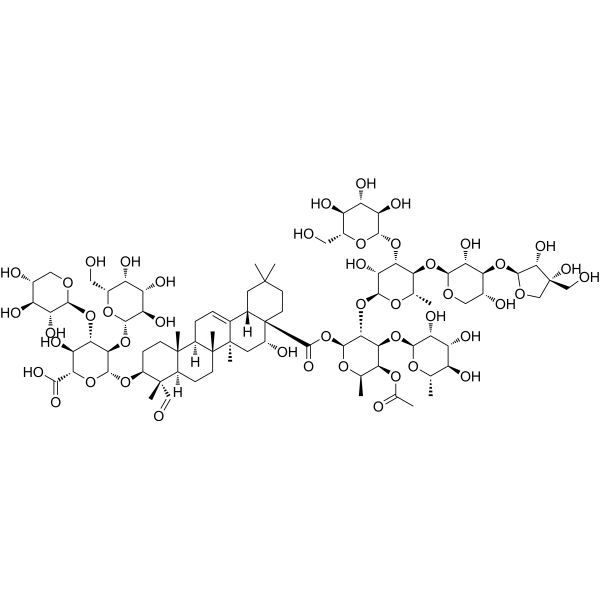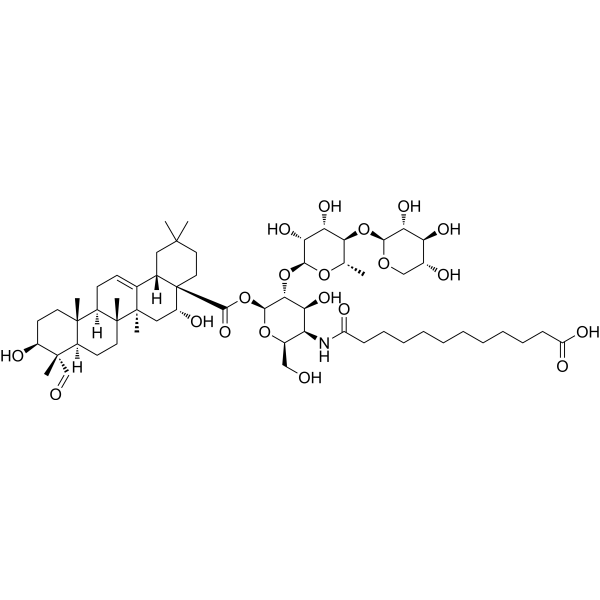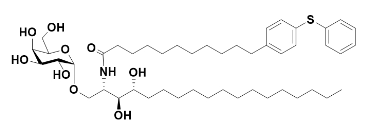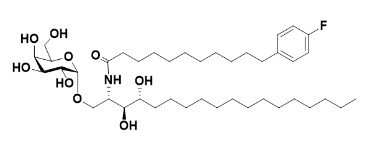| DC67236 |
QS-7
Featured
|
QS 7 (QS 7 Api) is a saponin compound that can be extracted from the Quillaja saponaria tree. QS 7 activates immune cells, enhances their antigen presentation ability and cytokine secretion. QS 7 can be used as vaccine adjuvant for immunostimulating, anti-tumor, and anti-infectious activities. |

|
| DC67237 |
TQL-1055
Featured
|
TQL-1055 is a semi-synthetic analog of the saponin adjuvant QS-21 (HY-101092) and can be used as a prophylactic vaccine adjuvant. TQL-1055 exhibits robust adjuvant activity for influenza antigens. TQL-1055 combined with the acellular pertussis vaccine (aP) shows good tolerance and enhances the antibody response to pertussis toxin (PT) in mice and rabbits. TQL-1055 is promising for research of chronic hepatitis B. |

|
| DC67238 |
KRN-7000(C34)
Featured
|
|

|
| DC67239 |
KRN-7000(S34)
Featured
|
|

|
| DC67240 |
KRN-7000(7DW8-5)
Featured
|
|

|
| DC67244 |
AS01 |
A combination of immunostimulants QS-21 and MPL with liposomes |

|
| DC67245 |
AS02 |
A combination of immunostimulants QS-21 and MPL with an oil in water emulsion |

|
| DC67246 |
AS03 |
A combination of an oil in water emulsion with alpha-tocopherol (Vitamin E) as immuno-enhancing component |

|
| DC67247 |
AS04 |
MPL is adsorbed onto aluminum hydroxide or aluminum phosphate, depending on the vaccine with which it is used |

|
| DC67248 |
AS15 |
A combination of immunostimulants CpG 7909, QS-21 and MPL with liposomes |

|
| DC67249 |
MF59 |
MF59 represents a highly efficacious oil-in-water emulsion adjuvant, renowned for its commendable safety profile and its capacity to mitigate immunosenescence—the age-associated decline in immune function—particularly in the elderly population. Primarily engineered for incorporation into influenza vaccines, MF59-adjuvanted formulations have demonstrated superior efficacy in eliciting robust immune responses among older adults when juxtaposed with conventional inactivated influenza vaccines. The adjuvant's formulation is characterized by squalene droplets, meticulously stabilized with minimal quantities of the surfactants Tween 80 and Span 85. This unique composition not only augments the immunogenic potential of influenza antigens but also broadens the spectrum of the immune response. It achieves this by enhancing cross-reactivity against viral strains that are not explicitly represented within the vaccine, thereby offering a more comprehensive protective umbrella against influenza. |

|
| DC67250 |
CAF01 (Cationic Adjuvant Formulation 01) |
CAF01 (Cationic Adjuvant Formulation 01) is a lipid-based adjuvant system comprising cationic liposome dimethyldioctadecylammonium bromide (DDA) and immunomodulator trehalose 6,6'-dibehenate (TDB). It enhances antigen-specific immune responses, particularly Th1-type cellular immunity, by stabilizing cationic liposomes for antigen delivery and activating innate immunity via TDB's interaction with receptors like Mincle.
CAF01 has shown promise in vaccine development, especially for tuberculosis, by boosting immunogenicity and inducing durable immune memory. Its proven safety and biocompatibility in clinical trials support its potential for human vaccine applications. In summary, CAF01 is a versatile and effective adjuvant, offering robust immune enhancement for novel vaccine strategies. |

|
| DC67251 |
CAF09 (Cationic Adjuvant Formulation 09) |
CAF09 (Cationic Adjuvant Formulation 09) is a novel liposome-based vaccine adjuvant system composed of the cationic liposome dimethyldioctadecylammonium bromide (DDA), the immunostimulant trehalose 6,6'-dibehenate (TDB), and the TLR3 agonist polyinosinic-polycytidylic acid (Poly(I:C )). This combination endows CAF09 with unique immunomodulatory properties, enabling it to simultaneously activate both innate and adaptive immune responses, particularly demonstrating remarkable efficacy in inducing robust Th1 and CD8+ T cell responses.
CAF09 enhances antigen uptake and presentation through its cationic liposome structure, while TDB activates C-type lectin receptors (such as Mincle) to amplify innate immune signaling. Additionally, Poly(I:C ) further strengthens immune activation via the TLR3 pathway. This multimodal immunostimulatory mechanism allows CAF09 to significantly enhance antigen immunogenicity and induce broad immune protection, encompassing both humoral and cellular immunity.
Research has shown that CAF09 holds great potential in the development of various vaccines, particularly for viral infections and cancer immunotherapy. Its potent immune-enhancing effects and favorable safety profile have been validated in preclinical studies, laying a solid foundation for its future application in human vaccine development. In summary, CAF09, as a highly effective and multifunctional adjuvant, provides robust technical support for the design and optimization of next-generation vaccines. |

|
| DC67252 |
Quil A |
Quil A, a natural saponin adjuvant derived from Quillaja saponaria bark, is known for its strong immunostimulatory effects. It promotes Th1 immunity and cytotoxic T cell responses by enhancing antigen uptake and cytokine release. Widely used in veterinary vaccines (e.g., for foot-and-mouth disease and rabies), its natural form can be toxic, leading to purified or modified versions like QS-21 to reduce side effects. Recently, Quil A has shown promise in human vaccines, particularly for cancer and antiviral applications, due to its unique immune-boosting properties. In summary, Quil A is a versatile adjuvant with significant potential in both animal and human vaccine development. |

|
| DC67253 |
Montanide 206 |
Montanide 206 is a water-in-oil-in-water (W/O/W) emulsion adjuvant by SEPPIC, enhances antigen immunogenicity and induces long-lasting immune responses by prolonging antigen release at the injection site. Suitable for vaccines requiring strong humoral and cellular immunity, it is widely used in veterinary vaccines (e.g., foot-and-mouth disease, swine fever) and shows promise in human vaccines, particularly for cancer and infectious diseases. Known for its biocompatibility, low toxicity, and ease of use, Montanide ISA 206 is a versatile adjuvant for vaccines needing potent and durable immune responses. |

|
| DC67254 |
Montanide 51 |
Montanide 51 is a water-in-oil (W/O) emulsion-based vaccine adjuvant developed by SEPPIC. It creates a stable oil-phase microenvironment that prolongs antigen retention at the injection site, enhancing antigen immunogenicity and inducing potent immune responses. Montanide ISA 51 is particularly suitable for vaccines requiring strong cellular and humoral immunity, such as cancer vaccines and therapeutic vaccines.
This adjuvant is characterized by its high immune-enhancing capacity, excellent stability, and compatibility with various antigens. Montanide ISA 51 has shown remarkable efficacy in cancer vaccine development, effectively activating antigen-specific T cell responses and promoting anti-tumor immunity. Additionally, it has been used in research for vaccines against infectious diseases, such as HIV and malaria.
In summary, Montanide ISA 51, as an efficient water-in-oil adjuvant, provides critical technical support for the development of therapeutic and cancer vaccines through its unique sustained-release mechanism and immune-enhancing properties. It is particularly effective in scenarios requiring robust cellular immune responses. |

|
| DC67255 |
Montanide 50 |
Montanide 50 is a water-in-oil (W/O) emulsion-based vaccine adjuvant developed by SEPPIC. It forms a stable oil-phase microenvironment that prolongs antigen retention at the injection site, enhancing antigen immunogenicity and inducing potent immune responses. Montanide ISA 50V is particularly suitable for vaccines requiring robust cellular and humoral immunity, such as cancer vaccines and therapeutic vaccines.
This adjuvant is characterized by its high immune-enhancing capacity, excellent stability, and compatibility with various antigens. Montanide ISA 50V has demonstrated significant efficacy in cancer vaccine development, effectively activating antigen-specific T cell responses and promoting anti-tumor immunity. Additionally, it has been utilized in research for vaccines against infectious diseases, such as HIV and malaria.
In summary, Montanide ISA 50V, as an efficient water-in-oil adjuvant, provides critical technical support for the development of therapeutic and cancer vaccines through its unique sustained-release mechanism and immune-enhancing properties. It is particularly effective in scenarios requiring strong cellular immune responses. |

|
| DC67256 |
LAS-OI01 |
LAS-OI01 is a novel LNP (Lipid Nanoparticle) vaccine adjuvant and immunotherapeutic agent that combines a dual-adjuvant molecular system comprising CpG 2007 (a TLR9 agonist) and a TLR7/8 activator. This combination elicits robust and long-lasting cellular and humoral immune responses, significantly enhancing the immunogenicity of vaccines. The LNP lipid nanoparticles optimize the uptake and activation of immune cells by efficiently delivering antigens and adjuvant molecules, thereby improving the strength and durability of immune responses.
This adjuvant system is suitable for a wide range of animal vaccines, including those for pigs, cattle, sheep, horses, chickens, ducks, geese, fish, dogs, and cats. It demonstrates particularly notable efficacy in vaccines against complex pathogens such as bacteria, viruses, fungi, and parasites. Research indicates that LNP lipid nanoparticles can enhance the immunostimulatory effects of CpG 2007 by 5-10 times, while the inclusion of the TLR7/8 activator further synergistically boosts Th1-type immune responses and antibody production.
In summary, the LNP lipid nanoparticle adjuvant system, with its efficient delivery capability and dual-adjuvant synergy, provides powerful technical support for animal vaccines and immunotherapy. It excels in scenarios requiring strong immune protection against complex pathogen infections. |

|
| DC67257 |
LAS-OI03 |
LAS-OI03 is a novel LNP (Lipid Nanoparticle) vaccine adjuvant and immunotherapeutic agent that combines a dual-adjuvant molecular system comprising CpG 1018 (a TLR9 agonist) and a TLR7/8 activator. This combination elicits robust and long-lasting cellular and humoral immune responses, significantly enhancing the immunogenicity of vaccines. The LNP lipid nanoparticles optimize the uptake and activation of immune cells by efficiently delivering antigens and adjuvant molecules, thereby improving the strength and durability of immune responses.
This adjuvant system is suitable for the development of various human prophylactic and therapeutic vaccines, particularly demonstrating notable efficacy in vaccines against complex pathogens such as bacteria, viruses, fungi, and parasites. Research indicates that LNP lipid nanoparticles can enhance the immunostimulatory effects of CpG 1018 by 5-10 times, while the inclusion of the TLR7/8 activator further synergistically boosts Th1-type immune responses and antibody production.
In summary, the LNP lipid nanoparticle adjuvant system, with its efficient delivery capability and dual-adjuvant synergy, provides powerful technical support for human vaccines and immunotherapy. It excels in scenarios requiring strong immune protection against complex pathogen infections. |

|
| DC67258 |
ODN 1018 |
ODN 1018 (1018 ISS), an oligodeoxynucleotide, is a TLR-9 agonist. ODN 1018 is also a synthetic immunostimulatory sequence that can be used as vaccine adjuvant. Sequence: 5′-TGACTGTGAACGTTCGAGATGA-3′.
The free form of the compound is prone to instability, it is advisable to consider the stable salt form (ODN 1018 sodium) that retains the same biological activity. |

|
| DC67259 |
ODN 2006 Sodium |
Agatolimod sodium (ODN 2006) is a class B CpG ODN and is a TLR9 agonist. Agatolimod sodium can be used as vaccine adjuvant. Agatolimod sodium can be used for the research of cancer. Sequence: 5’-TCGTCGTTTTGTCGTTTTGTCGTT-3’. |

|
| DC67261 |
ODN 2007 |
ODN 2007, a class B CpG ODN (oligodeoxynucleotide), is a Toll-like receptor (TLR) ligand. ODN 2007 can be used as an immunomodulator, vaccine adjuvant, and enhance immune responses in mammals, fish, and humans. ODN 2007 sequence: 5'-TCGTCGTTGTCGTTTTGTCGTT-3'.
The free form of the compound is prone to instability, it is advisable to consider the stable salt form (ODN 2007 sodium) that retains the same biological activity. |

|
| DC67260 |
ODN YW07 Sodium |
Activating canine splenocytes, enhancing anti-rabies virus antibody levels, stimulating specific immune responses, and boosting antibody production. |

|
| DC67262 |
PD-ODN 2006×3 Sodium |
Activating TLR9, inducing IL-6 secretion, and promoting the production of inflammatory factors through TLR9 activation. |

|
| DC67263 |
ODN D-SL03 |
ODN D-SL03 is a C class CpG oligonucleotides, can induce stimulate PBMCs to produce high level of IFN-α. ODN D-SL03 can activate human B cells, NK cells and mononuclear cells and up-regulate expression of CD80, CD86 and HLA-DR on the surface of subsets in human PBMCs. ODN D-SL03 also can inhibit the growth of the tumor. ODN D-SL03 sequence: 5'-tcgcgaacgttcgccgcgttcgaacgcgg-3'.
The free form of the compound is prone to instability, it is advisable to consider the stable salt form (ODN D-SL03 sodium) that retains the same biological activity. |

|
| DC67264 |
ODN SD-101 Sodium |
Enhancing dendritic cell maturation, stimulating T cell proliferation, and inducing the production of pro-inflammatory factors, upregulating CD83 and CD86, and promoting the maturation of IFN-DC and IL4-DC. |

|
| DC67265 |
ODN 2336 |
ODN 2336 is a A-Class CpG ODN (oligodeoxynucleotides), is a potent TLR9 agonist. ODN 2336 induces the production of IFN-α. ODN 2336 up-regulates the expression of IP-10 mRNA and IL-18 mRNA. ODN 2336 can be used as adjuvant of vaccines.
The free form of the compound is prone to instability, it is advisable to consider the stable salt form (ODN 2336 sodium) that retains the same biological activity. |

|
| DC67266 |
ODN 2216 |
ODN2216 is a human-specific TLR9 (toll-like receptor 9) ligand or agonist. ODN2216 induces high amounts of IFN-α and IFN-β. ODN 2216 induces IFN-α by pDC (plasmacytoid DC) and IL-12 (p40) production by DC (dendritic cells). ODN 2216 stimulates IFN-γ production in peripheral blood mononuclear cells (PBMC), which is indirect and mediated by IFN-α/β. ODN 2216 can activate NK cells and promote IFN-γ production of TCR-triggered CD4+ T cells.
The free form of the compound is prone to instability, it is advisable to consider the stable salt form (ODN 2216 sodium) that retains the same biological activity. |

|
| DC67267 |
CpG-ODN no.2 Sodium |
Inducing a TH1-type immune response, enhancing IFN-γ production, activating TH1 cells, and strengthening cell-mediated immune responses. |

|
| DC67268 |
ODN 21798 Sodium |
Inducing the production of IFNα and the chemokine IP-10, stimulating immune cells to produce chemokines, and enhancing immune cell migration. |

|





























